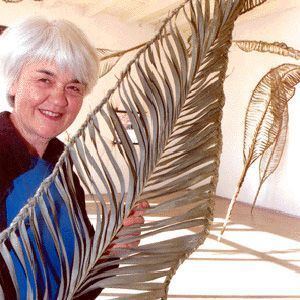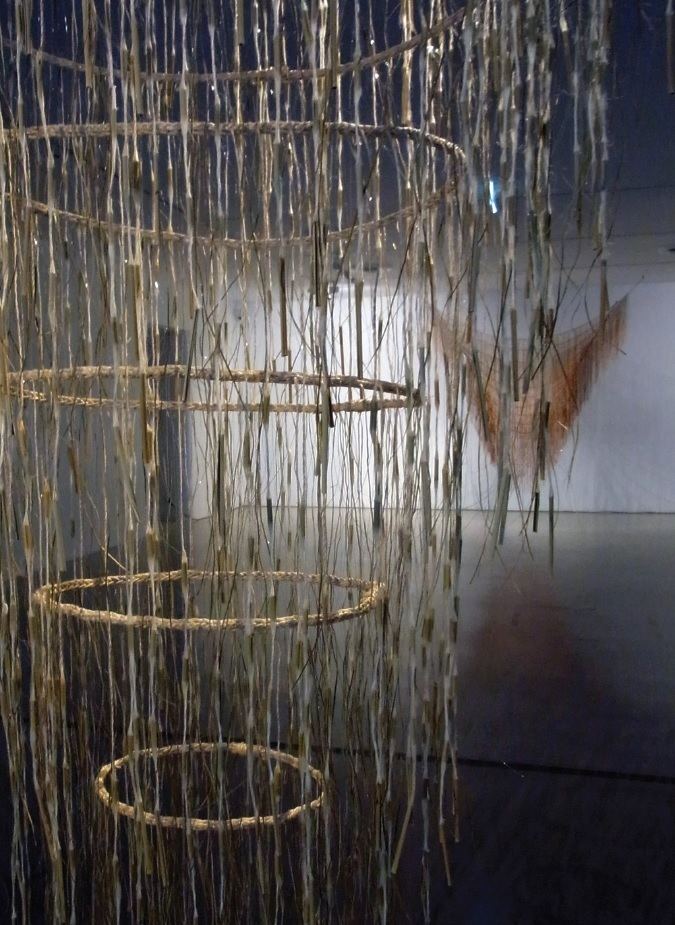Name Maureen Lander | ||
 | ||
Books Whetu, Whenu, Whenua, Hotere Country: An Exhibition Featuring Ralph Hotere's ''Song of Solomon." | ||
Dr maureen lander learning from diggeress te kanawa
Dr. Maureen Lander was born in 1942 in Rawene, New Zealand. She is a weaver, multimedia installation artist and academic of Ngāpuhi, Te Hikitu, Irish, Scottish and Yorkshire descent. Lander is a well-respected and significant Māori artist who since 1986 has exhibited, photographed, written and taught Māori art. She continues to produce and exhibit work as well as attend residencies and symposia both nationally and internationally.
Contents
- Dr maureen lander learning from diggeress te kanawa
- Dr maureen lander maori weavers making the most of the changing world
- Education
- Career as an educator
- Work
- Selected Exhibitions
- Selected publications
- Awards
- Residencies
- References

Dr maureen lander maori weavers making the most of the changing world
Education
Lander began learning weaving with noted Māori weaver Diggeress Te Kanawa in 1984 and spent many years researching fibre arts. In 2002 she was the first person of Māori descent to gain a Doctorate in Fine Arts at a New Zealand university.
Career as an educator
Lander worked as a teacher before attending Elam School of Fine Arts. From 1986 she worked as a photographer for the University of Auckland’s Department of Anthropology. She taught Maori fibre arts over many years, mainly in the Māori Studies Department at the University of Auckland where she was a Senior Lecturer in Māori Material Culture. In 2007 she retired from university lecturing.
Work
Lander was first introduced to muka (flax fibre) by Diggeress Te Kanawa and describes her three decades working with the material as a 'journey of discovery'. In a recent artist statement Lander said:
I was seduced by the beauty and magic of muka. My first public installation in 1986 – E kore koe e ngaro he kakano i ruia mai i Rangiatea in the Karanga, Karanga exhibition – featured whenu (warp threads) and aho (weft threads) that I had carefully prepared to make my first korowai. Instead, I suspended them in an ethereal cloud-like formation over a swirl of flax seed.
In 1998 art historian Priscilla Pitts wrote that Lander's combination of 'conventional university art school' study and training with traditional Māori weavers was reflected in her work:
Though much of her work is a response to weaving arts, Lander seldom actually weaves - at least, in the works she exhibits in gallery spaces. Rather, she uses, often to astonishing effect, the materials used in traditional Maori weaving and dying. These include pingao and feathers, but most of all harakeke (New Zealand flax) in all its forms - its leaves, its handsome flower and seed heads, the seeds and muka (the fine silky fibre obtained from the leaves). With these she combines materials from the Western world.
Pitts gives Lander's 1994 work This is not a kete, made for the exhibition Art Now at the former Museum of New Zealand (now the Museum of New Zealand Te Papa Tongarewa) as an example of the way her work combines traditional Māori crafts and Western sculptural or installation practices. Lander's work plays on Rene Magritte's famous painting Ceci n'est pas une pipe with a woven kete (flax basket) placed on top of a plinth with the words 'This is not a kete' inscribed on it. More kete were arranged on the floor of the gallery and dramatically lit. Pitts writes
'Here, in the context of the art exhibition, 'practical' objects - simple woven flax bags - are elevated to the status of art objects. ... However, this particular art exhibition was located in what was also an ethnography and history museum, within which the collection, cataloguing, and display of things like kete divorces them from their cultural, spiritual and/or utilitarian contexts and transforms them into artefacts.
In 2006 Lander was one of fifteen New Zealand artists, most of Māori and Pacific Island descent, who were invited to take part in the Pasifika Styles exhibition by making site-specific works throughout the Museum of Archaeology and Anthropology, University of Cambridge that responded to objects in the museum's collection. For the exhibition Lander reworked two previous commissions, This is not a kete and pieces from Mrs Cook's kete, a 2002 collaboration with Christine Hellyar at the Pitt Rivers Museum at Oxford University. Lander also made new pieces, including the site-specific installations Airy-Theory Artefacts (woven objects suspended in front of a screened window) and Tane Raises His Eyebrows (a crescent-shaped weaving placed over a decorative wooden door lintel). She also made a piece titled Crown Grab Bag for the exhibition, a large woven crown placed on a royal purple silk pillow with gold tassels. In the publication accompanying the exhibition, Museum of Archaeology and Anthropology curator Anita Herle wrote
The work references the New Zealand Foreshore and Seabed Act of 2004, which empowered the New Zealand government, 'the Crown', to override tribal rights to pursue customary claims to the foreshore and seabed through the courts. Lander's crown is delicately woven from a variety of fibres, including plant materials that grow along the foreshore - the creation of the crown itself is thus a subtle but defiant act of re-appropriation. Shells and fishing hooks from the museum's collection are placed on the base of the case. Strands of pingao fibre, stitched into the fabric lining at the back of the case, form inverted U-shapes representing the raised eyebrows of Tane (god of the forest). According to Māori legend, following a dispute between Tane and Tangaroa (god of the sea) Tane's eyebrows were flung onto the sand dunes, which mark the liminal space between the forest and the sea. Here Lander connects contemporary political conflicts to legendary battles.
Responding to objects and taonga held in cultural institutions' collections remains a strong feature of Lander's work. In a 2015 exhibition at the National Library of New Zealand (a collaboration with Christine Hellyar and Jo Torr) Lander made a number of works relating to works in the library's art and archival collections. Her piece Hariata’s War Garb is inspired by Joseph Merrett’s 1846 watercolour The Warrior Chieftains of New Zealand. The portrait depicts Hone Heke, the chief Kawiti, and Heke’s wife Hariata. Hariata is shown wearing a woven sash unlike anything Lander had seen before. Researching her own family history, Lander found descriptions of Hariata written by her great-great grandfather James Johnston Fergusson. One document describes Hariata leading 700 men; another as being ‘young, tall, and rather goodlooking’, wearing ‘a tartan dress with red sash slung around her shoulders like a shepherd’s plaid’. Lander recreated the sash for the exhibition, along with a number of other pieces. In a review of the exhibition art historian Jill Trevelyan noted that Lander drew on her own experience learning weaving under Diggeress Te Kanawa to produce the works Rongo's samplers, a reimagining of the first works produced by a new practitioner.
Selected Exhibitions
Lander began exhibiting her artwork in 1986. Having exhibited both nationally and internationally, Lander currently enjoys exhibiting with other artists in the small communities around the Hokianga where her ancestors lived.
